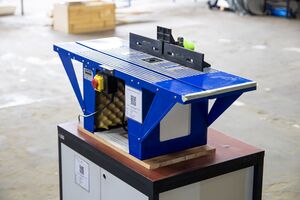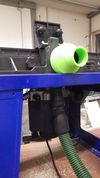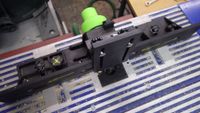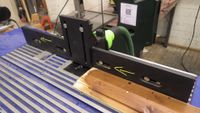Archived:Westfalia Universal Frästisch Nr. 64 56 97: Difference between revisions
→Improvements/Upgrades: depth gauge usage |
NitramLegov (talk | contribs) m Leading empty line |
||
| Line 1: | Line 1: | ||
==Westfalia Universal Frästisch Nr. 64 56 97== | ==Westfalia Universal Frästisch Nr. 64 56 97== | ||
{{MachineInfoBox | {{MachineInfoBox | ||
Revision as of 10:24, 22 January 2024
Westfalia Universal Frästisch Nr. 64 56 97
| MachineInfoBox Westfalia Universal Frästisch Nr. 64 56 97 | |
|---|---|

| |
| Synonyms: | DE: Frästisch, Oberfrästisch, stationäre Oberfräse |
| Type: | Router Table |
| Material: | wood |
| Used with: | compatible routers, push blocks |
| Location: | |
| Access Requirements: | Router Table Introduction |
| Status: | Gone |
| Tutors: | Lukas NitramLegov Pakue Luzian Keno Utis Mobell |
| Similar (More or Less): | table saw |
Compatible Routers
These routers can be attached to the table.
- Makita 3612BR (default)
- do not remove without good reason!
- Ferm FBF-1050E (backup)
- caution: the mounting plate is off-center!
- bottom dust extraction requires the rear table cover to be removed
Setup
(Emergency) Stop
To stop the router, you can slap the lid of the yellow switchbox or use the foot switch. When stopping inside a cut, the foot switch is highly recommended so you can keep your hands on the workpiece for full control!
In addition to unplugging the whole setup, please make a habit of "locking" the switchbox between uses (unlocked by pushing the red cover upwards) so we have maximum protection against accidental starts.
Dust Extraction

For edge work, you can use the top (green) dust port in the fence, but for grooves you should connect the shop vac to the bottom port in the rear cover of the table (Ferm router: black dust port on the machine itself). Keep in mind that the top port will only work if there is at least a small gap in the fence!
It will still be pretty messy work - a router generates lots of shavings - but should help reduce the amount of fine dust flying around.
Fence

The fence consists of several parts which need to be aligned carefully if you want it to be accurate. In most cases (working with a parallel fence), you will not need the knob labeled "X", so please don't mess with it too much...the next user will thank you!
There is a scale on the table to set the fence's distance from the center of the router bit, but it is rather rough and doesn't allow accurate fine measurements. A height/depth gauge, easily made from a caliper and some scrap wood, would be a nice solution (similar to this Instructable, but there are better ones around for sure).

Once you have your bit inserted, the fence's two sliding front sections should be brought as close together as possible for maximum workpiece support and a focused airflow to the dust extraction port. The top guide should be brought down until it nearly touches your workpiece. The frontal guide works the same - we should make compatible featherboards that could actually press the workpiece to the table/fence for even more support.
Unfortunately, the current screw knobs have to be turned very tightly or vibrations will cause everything to shift over time - perhaps we can exchange these knobs with locking levers so that they can be adjusted without pliers.
Improvements/Upgrades
Any modifications to the table or router itself should be discussed with the owner (Martin) in advance and security-checked by a manager afterwards!
done:
- 3D printed shop vac adapter (needed some further adjustment with the table saw) - is the file available somewhere?
- cut two protruding corners from the front guide bracket so it stay mounted to the table all the time without getting in the way
- make push blocks
- get a depth gauge to set the fence distance or bit height
- HolzWerken: Fünf Tipps für die richtige Benutzung (DE)
further ideas:
- make featherboards with slots that fit to the existing guide brackets
- replace (at least) the star knobs connecting the fence and the table with locking levers or knobs with hex nuts that can be gripped with wrenches (do those exist?)
==> video showing these (and more) potential upgrades: Heiko Rech - Tipps zum Arbeiten mit dem Frästisch (DE)